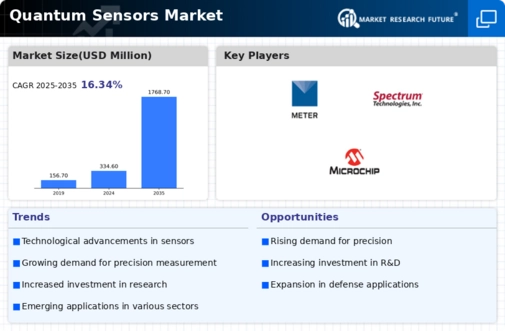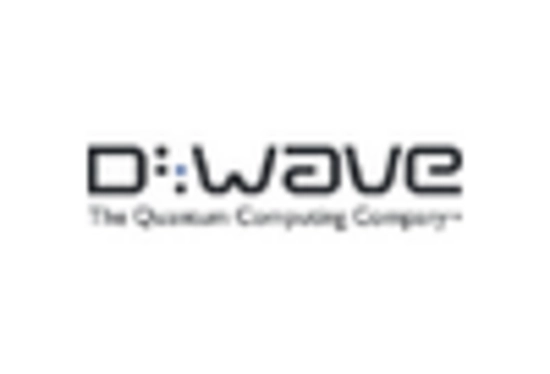The Quantum Sensors Market is currently characterized by a dynamic competitive landscape, driven by rapid technological advancements and increasing demand across various sectors, including telecommunications, healthcare, and defense. Key players such as IBM (US), Honeywell (US), and Google (US) are at the forefront, leveraging their extensive research capabilities and innovative technologies to enhance their market positioning. IBM (US) focuses on integrating quantum computing with sensor technology, aiming to develop solutions that can significantly improve data accuracy and processing speed. Meanwhile, Honeywell (US) emphasizes partnerships and collaborations to expand its product offerings and enhance its operational capabilities, particularly in industrial applications. Google (US) continues to invest heavily in research and development, seeking to pioneer new quantum sensing technologies that could redefine industry standards. Collectively, these strategies contribute to a competitive environment that is increasingly centered on innovation and technological advancement.
In terms of business tactics, companies are increasingly localizing manufacturing and optimizing supply chains to enhance efficiency and reduce costs. The Quantum Sensors Market appears moderately fragmented, with a mix of established players and emerging startups. This structure allows for a diverse range of products and services, fostering competition that drives innovation. The collective influence of key players is significant, as they not only set industry standards but also shape consumer expectations through their technological advancements.
In August 2025, IBM (US) announced the launch of its new quantum sensor platform, which integrates advanced machine learning algorithms to enhance sensor accuracy. This strategic move is pivotal as it positions IBM to capture a larger share of the market by offering cutting-edge solutions that address the growing need for precision in various applications, from environmental monitoring to healthcare diagnostics. The integration of AI with quantum sensing technology could potentially revolutionize data analysis and interpretation, providing IBM with a competitive edge.
In September 2025, Honeywell (US) entered into a strategic partnership with a leading aerospace company to develop quantum sensors specifically designed for navigation and positioning systems. This collaboration is significant as it not only expands Honeywell's product portfolio but also enhances its credibility in the aerospace sector, which is increasingly adopting advanced technologies for improved operational efficiency. The partnership underscores Honeywell's commitment to leveraging strategic alliances to drive innovation and market penetration.
In October 2025, Google (US) unveiled its latest quantum sensor prototype, which reportedly achieves unprecedented sensitivity levels. This development is crucial as it positions Google as a leader in the quantum sensing space, potentially opening new avenues for applications in fields such as telecommunications and environmental science. The emphasis on sensitivity and accuracy reflects a broader trend in the industry, where companies are striving to push the boundaries of what is technologically possible.
As of October 2025, the competitive trends in the Quantum Sensors Market are increasingly defined by digitalization, sustainability, and the integration of artificial intelligence. Strategic alliances are becoming more prevalent, as companies recognize the value of collaboration in driving innovation and expanding market reach. Looking ahead, competitive differentiation is likely to evolve, shifting from traditional price-based competition to a focus on technological innovation, reliability in supply chains, and the ability to deliver sustainable solutions. This transition may redefine the competitive landscape, compelling companies to continuously adapt and innovate to maintain their market positions.
















Leave a Comment